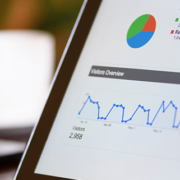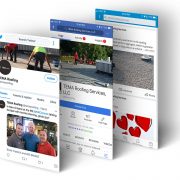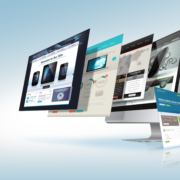2017 Web Design Trends | What to Look For…
“If you think math is hard, try web design.” ―Trish Parr
Capturing the attention of your audience within the first few seconds of a site visit is crucial. Research has shown that website visitors make judgements about the site’s credibility in as little as 50 milliseconds, and that one in five visitors will leave your website almost immediately if you don’t pique their interest during that crucial first view.
But, don’t fret! Creating websites that immediately impress your visitors is possible… if you stay current on the trends!
So what does 2017 have in store for web design?
FIRST THINGS FIRST – WEB DESIGN IS NOT ART.
Art is used to express feelings, raise questions, and provoke emotions. Design, however, is a means to display an answer to a problem that needs solved. Web design includes imagery, written content, and navigational pieces that allow a solution to evolve organically for the viewer. All elements of web design must serve a purpose.
Your website is not a digital wall from which you can hang all of your paintings! De-clutter – especially on websites that have been around for a while. Conduct a content audit and focus on where site viewers are in their buyer’s journey (awareness, consideration, or decision stage).
For new sites, consider using wireframes, sitemaps, and top tasks as your starting point. Clarity, however, is the top priority – Simple. Smart. Stylish – these are the results of great design.
GRIDS, FRAMEWORKS, AND PRE-MADE THEMES
Streamlining production for digital projects frees up a lot of time. Using grids, frameworks, and pre-made themes can cut down on development time and often solves responsiveness issues.
Bootstrap, UlKit, and Foundation are tried and true, but new front-end development frameworks from Suzy, Jeet and Breakpointare showing promise, too.
Pre-made themes from TemplateMonster are also a good choice. The developers of these templates are continuously seeking to improve their product, so they rely heavily on feedback from consumers (this allows them to make upgrades that increase user friendliness and overall effectiveness).
FLAT COLORS
Google Material Design is a set of principles and best practices for web designers and mobile app developers, taking designers back to the basics by helping them focus on what’s most important. It also allows for multiple resolutions and easy viewing on various devices.
Google Material Designs’ flat colors aren’t the only approach to web and mobile app design, but they continue to be extremely popular. An excellent example of Google Material Design principles can be seen on the Fabulous app (and if you’re looking to set some resolutions for 2017, this app is a great place to start)!
AUTHENTIC IMAGES
Relevant and genuine images are effective elements that provide power to web designs. Some considerations for choosing these images include:
- Product:
If product images are appropriate and useful to the website, they should always be first choice. Being able to showcase exactly what you have to offer is one of the most powerful things you can do.
- People:
Authentic images, that display how your product is used and how it benefits its users, can send a strong message. Depicting people benefitting from your product draws in consumers.
- Quality:
Showcasing the expertise or materials that set you apart from the competition allows potential consumers to have confidence in their purchase.
- Ethics:
If your organization is working to make the world a better place, show it off! People want to connect with organizations that have a conscience.
Be sure to use original photography, when possible, so that your website doesn’t end up looking dated. Choose realistic images that portray the real world and the real people who live there. Don’t be afraid to try new perspectives such as selfies, drone, or head-on pictures and videos!
VIDEO
A background video playing on your homepage can tell your story within seconds (and seconds may be all you have in order to catch the attention of your viewers).
Video is being utilized by more brands and individuals than ever before, and its growth trajectory will only continue to spike upward. Social media users want more “in-the-moment” content, and viewers of websites want to feel like they are part of the experience.
NAVIGATION
The number of visible, main menu navigation items is now reduced to the absolute minimum. With the continued influence of mobile design, hamburger navigation icons (a button in a graphical user interface, carrying an icon consisting of three parallel horizontal lines – displayed as ☰) will become more popular than ever.
The jury is still out, though, in regard to the effectiveness of this approach. However, research is showing that hamburger lines combined with a menu label work significantly better than the hamburger icon alone (see Adobe’s use of this technique here).
PERFORMANCE AND INTELLIGENT ANALYTICS INSIGHT
Use of intelligent insight to understand what works and what doesn’t work for your website is becoming increasingly important. There’s a lot of competition on the internet, and being able to see beyond page views and unique visitors is imperative.
Website metrics must be considered in order to ensure that engagement with your site is quick and powerful – because, there is a HUGE difference between reach and engagement. Reach is fickle and means very little. But, engagement, on the other hand, is long-lasting and convertible. Create a call-to-action and TRACK the conversion ratios. Make your performace count!
CONCLUSION
2017’s most successful websites will be full of authentic images and responsive designs. Concise and succinct language is key, as are analytics and data. Navigation will be reduced to the minimum necessary and will include “hamburger” icons.
Micro interactions and bold images will continue to lead design trends, but the effectiveness of these elements depends highly upon the loading speed and ease of navigation. Now, more than ever, you literally have a split second to grab attention!
“If you can make the site load a second faster, you can drive engagement by 5%.” – Financial Times











